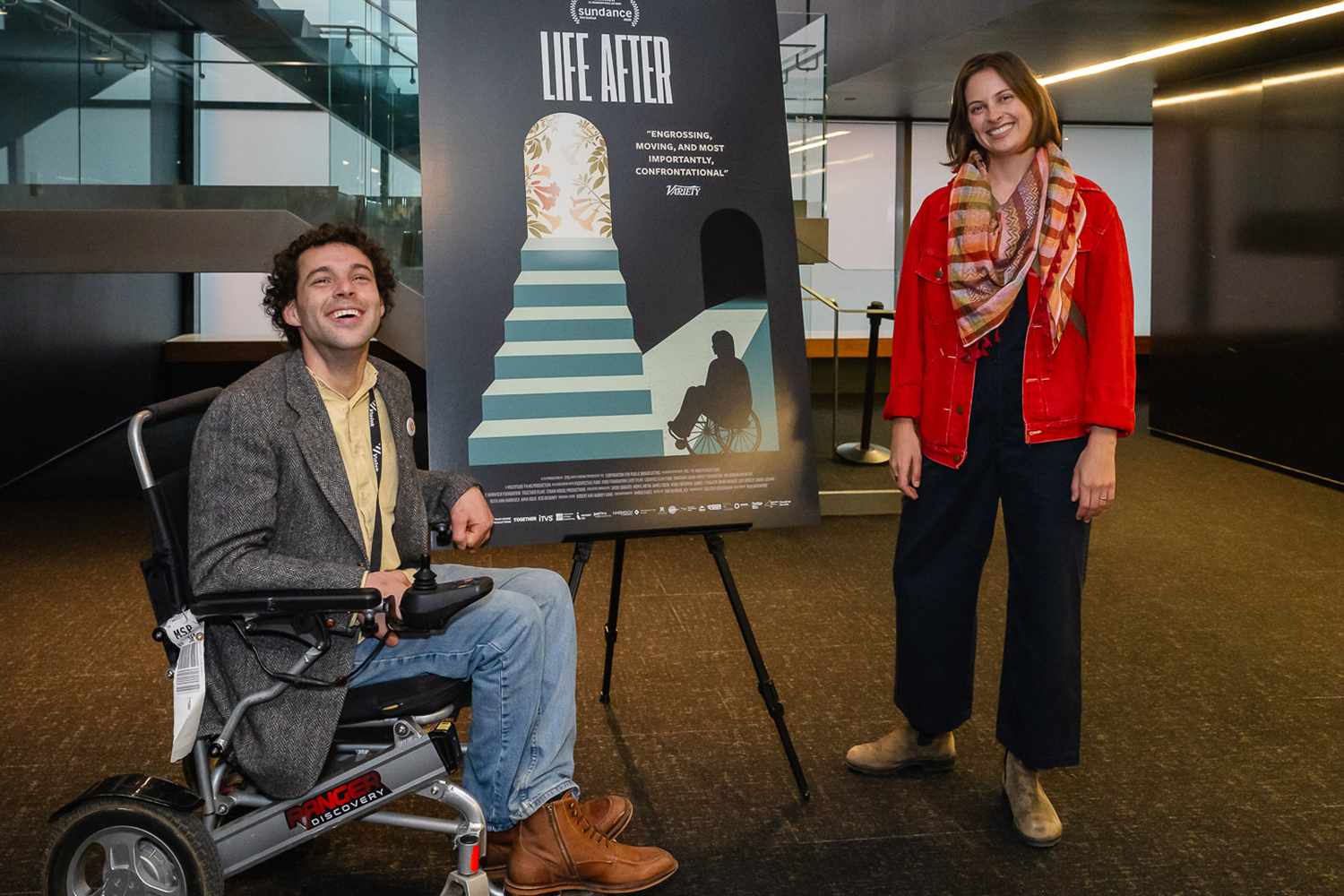Entertainment
A Disabled Woman Wanted to Starve Herself to Death. The State Wouldn’t Let Her. A New Doc Looks at Her Case (Exclusive)

NEED TO KNOW
- Director Reid Davenport’s new documentary Life After examines the right-to-die question through the experiences of disabled people
- Reid, who has cerebral palsy, uses the case of Elizabeth Bouvia, a young woman with cerebral palsy, as the centerpiece of the film
- Bouvia was denied the right to starve herself in 1983
Allowing a person with a dire health diagnosis or an unbearable level of pain to die might seem like an act of mercy to some people.
But what would happen if the government were to decide that anyone with a disability deserves the right to die? Filmmaker Reid Davenport confronts this question in his new documentary Life After, primarily through the story of Elizabeth Bouvia, a California woman with cerebral palsy who, at the age of 26, sought the legal right to starve herself to death.
This was in 1983, and some TV news broadcasts questioned why someone who was young and beautiful would want to end her life. She said she wanted to die because she hadn’t been given the right to live in a society with a healthcare structure that valued the bottom line over her well-being.
Davenport, who also has cerebral palsy, and his producing partner at Multitude Films, Colleen Cassingham, kept hearing similar reasoning while making Life After, which is now playing in select theaters.
Bouvia articulated her argument well when her case moved to court — she was in pain, tired and bogged down by bureaucracy — but the state eventually sided with the hospital, which said it could not betray its oath to first do no harm. So what happened to this so-called pioneer in the right-to-die movement after the case ended?
That is the question Davenport set out to answer when he started working on Life After. Framed by Bouvia’s story, the documentary explores expanded Canadian policies that allow nearly anyone with a disability to apply to die, why some disabled people have made the tough choice to die and how advocates for MAiD (medical aid in dying) defend the expansion of the policies from people with a terminal diagnosis to anyone with a disability.
The film amplifies varied voices and points of view, like Melissa Hickson, who says her husband Michael Hickson was denied lifesaving care because doctors decided his quality of life was too low, and Catherine Frazee, a professor who posits that you cannot address human suffering by killing people. One participant, Michal Kaliszan, details how he considered assisted dying after his mother, who was his primary caretaker, died, and he could no longer afford the care he needed.
While working on the documentary, Cassingham had to navigate a shift in taking right-to-die activism at face value as progressivism to fully understanding the implications of applying it to all disabled people.
“I thought assisted dying was really about personal choice and bodily autonomy, values that I’m deeply committed to,” she tells PEOPLE. “And in learning from Reid and in working on this film, I realized there’s so much more to the picture of how it actually works in society, and it’s deeply linked with the ways that we do and don’t value certain lives, and a deep-seated ableism that underpins so much of society.”
Over the course of Life After, as Davenport searches for Bouvia’s family and seeks to find out if she is still living, two themes emerge: that the focus on right-to-die policies ignores that so many disabled people are not given the right to live and that any one person deciding what a good quality of life is for someone else can be tricky.
“The themes at the heart of this film are not niche; they’re not particular to the disability community. Things like healthcare, isolation and the way that we value other human lives are universal,” Cassingham says. “Everyone has a stake in the fight for a society that is invested in care and in upholding each other’s dignity in the systems that we build and live within.”
Eventually, Davenport locates Bouvia’s sisters, Teresa and Rebecca, and convinces them to appear on camera to talk about their sibling, who died in 2014. Encouraging the pair to open up about Bouvia was not easy, but Davenport’s authenticity and transparency helped win them over.
“Their main concern was that Elizabeth’s reputation and decisions were going to be questioned again, and we ensured that was not our intention,” Davenport says. “Basically, trying to, with the audience, meet them where they were at, and not force them.”
As Teresa and Rebecca share stories of Bouvia’s life after the 1980s while the film visits people who have used or are considering using MAiD, it becomes clear that assisted dying may have its place in the medical system. However, as Davenport sees it, discussions about it should be handled carefully when the focus is on people with disabilities.
“We should be asking, ‘How can we enable disabled people to live?’ And support them, and allow them opportunities,” he says. “There’s this sinister perspective that we are a burden, that we suck up money. So there’s this underlying incentive for the health industry to allow people to choose assisted suicide.”
He continues, “What I would encourage people to do is to look at how we can better the lives of people with disabilities rather than leave them to die.”
Near the end of the film, Davenport fills out the application for Canada’s MAiD program to see how easy or hard it would be for him to qualify. What starts as a funny exercise becomes scary when he passes with flying colors. He reflects on this and on all the people he has met who have gone down the same path and says he can’t imagine how different he would feel about his life without the support, care and passion he has.
In one particularly poignant moment, Cassingham agrees that her quality of life would also be greatly reduced without these things, but because she doesn’t have a disability, she wouldn’t be given the option to die because of it.
“Quality of life doesn’t have much to do with the abilities of our bodies. When someone becomes disabled or is aging, there’s a real grappling with what that means, because society has told us that what makes us productive and able to enjoy life revolves around our bodies and our ability to do certain things,” she says. “But for me, I’ve experienced a real reframing of disability as a natural part of the fabric of human experience.”
“I’m learning that quality of life resides somewhere else, and it involves the people around you, it involves being loved, and giving love and care,” Cassingham adds. “And those are things we all have access to if we live in a society where care is fostered and relationships and interdependency is valued and fostered.”
While Bouvia’s life after her landmark court case quickly fell out of the news cycle, Davenport’s film reappraises the right-to-die question — through the sweet recollections of Bouvia’s sisters, home video footage and the context of many others who are choosing to die or questioning why it is even an option.
Life After is now playing in select theaters
Read the full article here

-

 Entertainment5 days ago
Entertainment5 days agoKate Middleton and Prince William Ensure Prince Louis Doesn’t Miss Out on Special Gift from Wimbledon Champion Jannik Sinner
-

 Entertainment6 days ago
Entertainment6 days agoKylie Jenner shares stunning bikini looks on Greece vacation
-

 Royals4 days ago
Royals4 days ago‘Real Housewives of London’ star forbidden from asking King Charles about Prince Harry and Meghan Markle
-

 TV6 days ago
TV6 days agoHow Cierra feels about Nic and Olandria recoupling
-

 Celebrity3 days ago
Celebrity3 days agoPete Davidson’s girlfriend, Elsie Hewitt, posted about ‘chaotic’ month just before announcing pregnancy
-

 Music7 days ago
Music7 days agoJustin Bieber lusts over wife Hailey’s bikini pics
-

 Royals7 days ago
Royals7 days agoKate Middleton attends Wimbledon after admitting to having to put on a ‘brave face’ following her cancer battle
-

 Gossip3 days ago
Gossip3 days agoSeating scuffle breaks out at socialite’s Bastille Day bash















